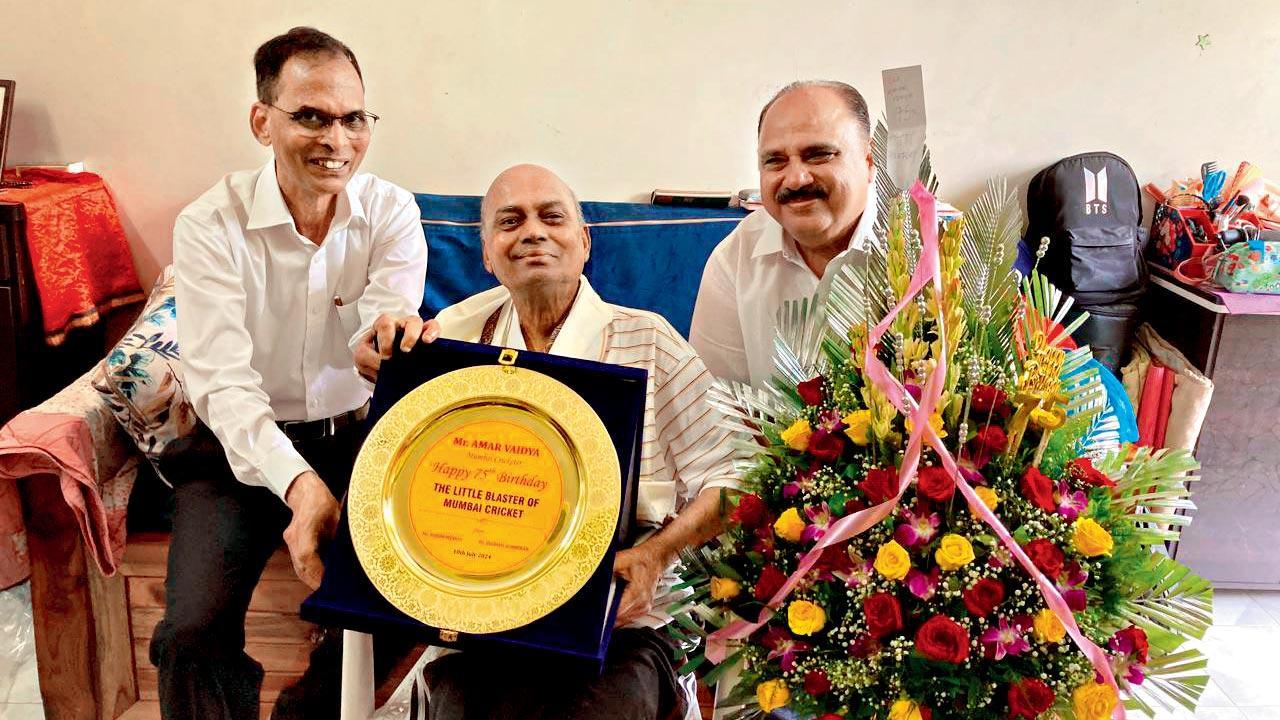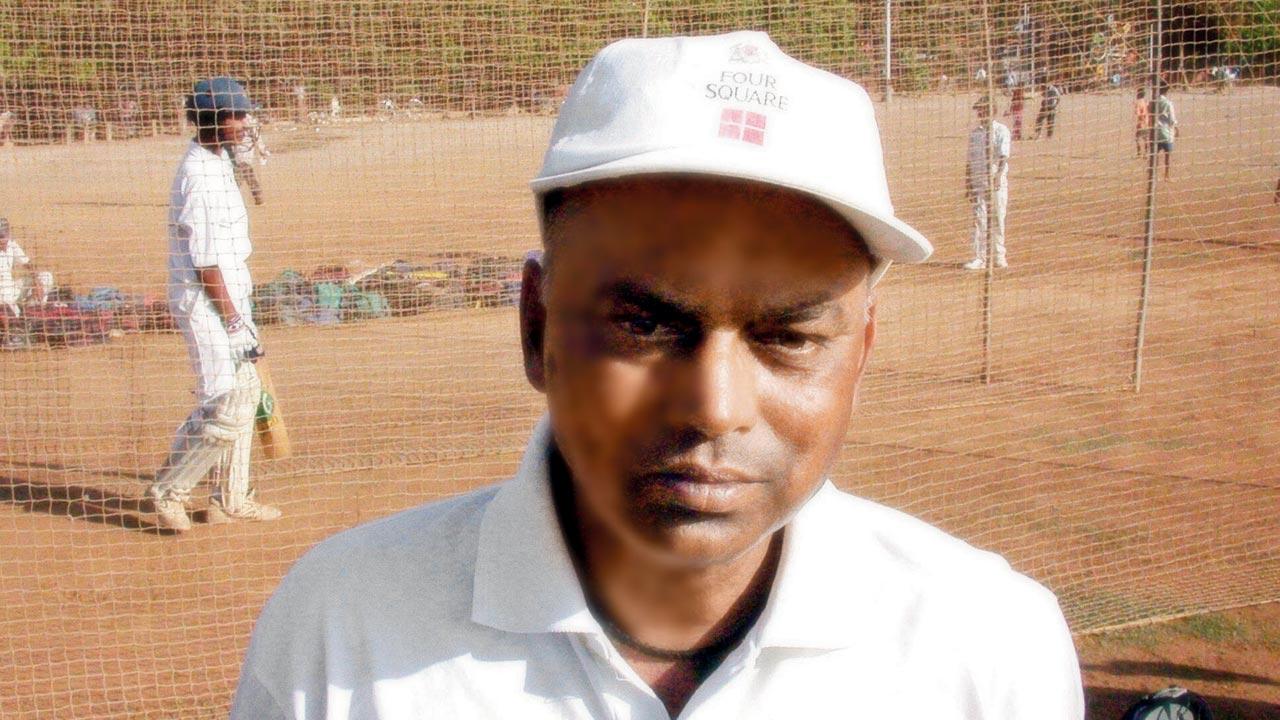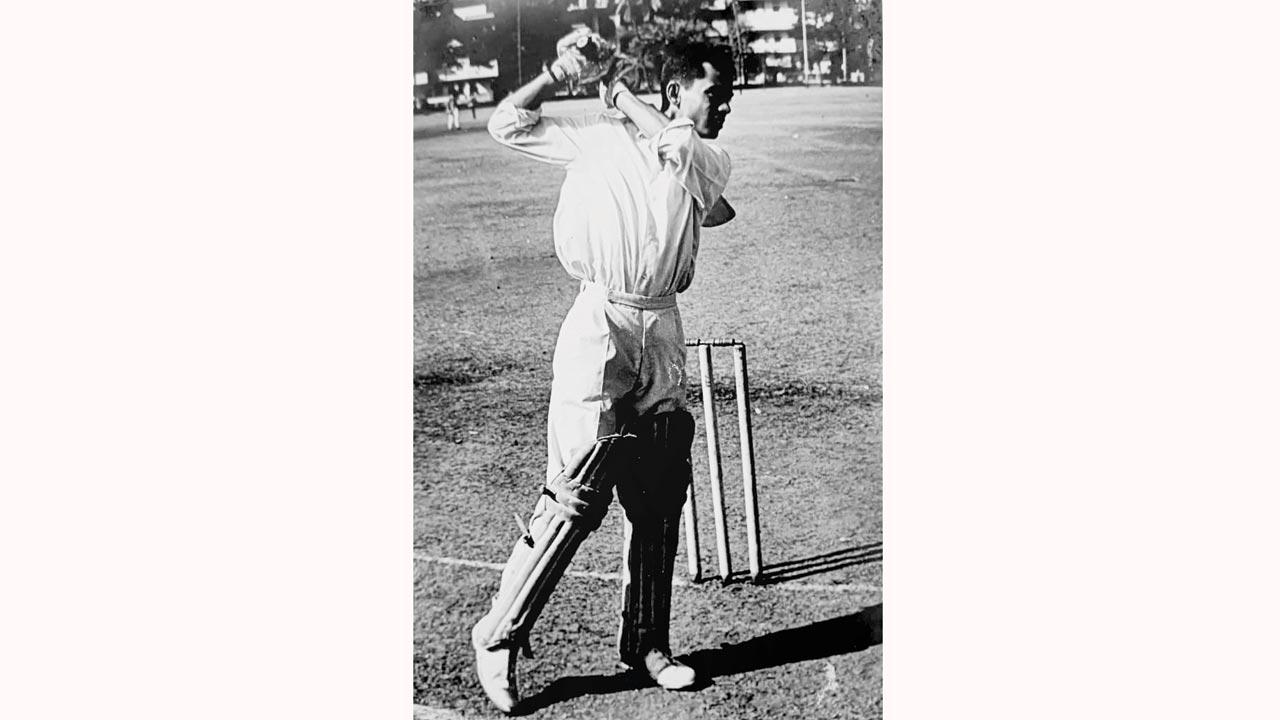Like India’s batting legend and commentator Sunil Gavaskar who turned 75 on July 10, his former Dadar Union Sporting Club teammate reached the same milestone that very day; the bedridden cricketer-turned coach’s guests being two former Mumbai Cricket Association administrators Nadim Memon and Jagdish Achrekar

Former MCA treasurer Jagdish Achrekar and ex-MCA managing committee member Nadim Memon (right) present a salver to Amar Vaidya at his Matunga residence on July 10
While the cricketing world came together to celebrate Sunil Gavaskar’s 75th birthday on July 10, a lesser known teammate of the batting legend reached his life’s score of 75 on the same day.
ADVERTISEMENT
Not only Amar Ankush Vaidya is lesser known, his health is a complete antithesis to that of Gavaskar’s.
Vaidya was Gavaskar’s teammate at Dadar Union Sporting Club.
He reached the highest echelons of the local cricket scene as a middle order left-handed batsman. And the attacking brand of batting he displayed caused fear among opposition bowlers.
Also Read: "He will do well as he gets that experience": Tushar Deshpande's father on his son's debut
 Amar Vaidya during his coaching days at Shivaji Park
Amar Vaidya during his coaching days at Shivaji Park
Vaidya has been bedridden for several years. Diabetes has affected his vision, but at the heart of his health issues is a kidney failure that has driven Vaidya miles away from the cricket-heavy life he once loved to live.
His son Salil (a former Mumbai age group batsman and Ranji Trophy probable) tells us, that his father enjoyed watching red-ball and limited overs cricket on the television at his Matunga home until three years ago. Now, even if cricket is on the screen, Salil said his dad “practically doesn’t understand anything.”
The same Amar Vaidya took great care of his father Ankush in his old age. Ankush was better known as Anna, the famous coach who played a leading role in the emergence of Sandeep Patil. Anna coached several cricketers at Balmohan Vidyamandir and son Amar continued his father’s good work at the Shivaji Park school. He also guided cricketers at Mithibai College. Amit Pagnis, the former India U-19 captain as well as Mumbai and Railways Ranji Trophy batsman, was coached by Vaidya at school and college.
Pagnis credited Vaidya’s insistence on not being satisfied by a good innings amounting to a hundred. “I repeat his teachings to the players I coach now. His advice was based on staying keen on more runs and that’s what helped me in my career. You can say Amar Sir taught me to be hungry,” Pagnis said on Saturday.
 Amar Vaidya batting in the 1960s
Amar Vaidya batting in the 1960s
Salil revealed that his father’s coaching efforts at Mithibai College resulted in five junior inter-collegiate championships in the first part of the 1990s. Apart from Pagnis, Gaurav Jathar and Siddharth Chitnis were his students who played first-class and List A cricket.
Last Wednesday, two former Mumbai Cricket Association (MCA) officials — Nadim Memon and Jagdish Achrekar — visited Vaidya’s Mahim residence to present him a plaque on his landmark birthday.
“I got emotional seeing Amar. He was a big player for me and to play with him as well as Test player Ajit Pai in the Bank of Baroda team was an honour.
When I saw Amar on Wednesday I couldn’t help thinking about how he hit three sixes in an over off Padmakar Shivalkar in a Kanga League game,” said Achrekar. The ex-MCA Treasurer also remembered an inter-office game in which the glad tidings for a fast bowler named in the Mumbai Ranji Trophy squad was dampened by Vaidya, who slammed him for a plethora of boundaries on the day of his selection.
 The Dadar Union champion outfit of the 1970s. Front row (from left): VS Patil, Suresh Tigdi, Vasoo Paranjape (captain), Sunil Gavaskar, Urmikant Mody and Subhash Bandiwadekar. Back row (from left): Lakhandar (kit boy), Sanjay Jaywant, Jitendra Bhutta, Ramesh Rajde, Avinash Karnik, Raju Babla and Amar Vaidya. Pic courtesy: The late VS Patil Collection
The Dadar Union champion outfit of the 1970s. Front row (from left): VS Patil, Suresh Tigdi, Vasoo Paranjape (captain), Sunil Gavaskar, Urmikant Mody and Subhash Bandiwadekar. Back row (from left): Lakhandar (kit boy), Sanjay Jaywant, Jitendra Bhutta, Ramesh Rajde, Avinash Karnik, Raju Babla and Amar Vaidya. Pic courtesy: The late VS Patil Collection
Meanwhile, Memon had tears in his eyes at the Vaidya home. “Despite being my opponent in the inter-bank competitions, he used to urge me to perform better in the heat of the battle. He always encouraged us to look for singles,” Memon, who had played for IDBI, revealed.
Vaidya’s Bank of Baroda’s teammate Ajit Pai, the 1969-70 Test bowler, remembered Vaidya as a “tremendous batsman, who would square cut anything short outside off-stump.” He even praised his leadership, calling him “a calm, quiet and result-oriented captain.”
Rookies and thoroughbreds were treated in similar fashion by Vaidya’s punitive blade. India’s 1983 World Cup-winning batsman Sandeep Patil, no slouch when it came to big-hitting himself, called Vaidya a “destructive batsman who could spoil the opposition’s party.”
The former India star was coached by Vaidya Sr at Balmohan and locked horns with the junior Vaidya in club cricket. “I have seen Amar destroy great Shivaji Park Gymkhana attacks which had Ajit Naik, Abdul Ismail, Baloo Gupte, Vishoo Lele, Padmakar Shivalkar, VR Bondre and [Mukund] Satghare — limited footwork, maximum result,” Patil told mid-day.
It was rare in those days that a Dadar Union player didn’t end up playing Ranji Trophy cricket. Vaidya somehow didn’t get picked for Mumbai. This fact amazed followers of city cricket, including Patil. “He was a quiet bloke. I knew him well because of Anna, my coach. Even after playing for Dadar Union, he didn’t play for Mumbai and that is unfortunate. He should have represented Shivaji Park Gymkhana and Shivaji Park Youngsters then [to find a place in the Mumbai team],” added Patil.
Ex-Mumbai batsman Sanjay Jaywant recalled watching Vaidya’s brilliant batting before he joined the Dadar Union fold and became Vaidya’s teammate.
Dadar Union were never short of tall deeds from three diminutive batsmen in their ranks in the 1970s — Gavaskar, Ramnath Parkar and Vaidya.
Austin Coutinho, well known for his work as an artist now, was a fast bowler who played under Vaidya for Young Maharashtra. “Amar was my first ‘A’ division cricket captain — one of the nicest guys I’ve met in cricket. He would play shots that were out of this world. He would hit sixes over cover and even third man like he did in one Talim Shield semi-final or final for Young Maharashtra,” recalled Coutinho.
Vaidya proved to be a fine captain, who didn’t believe in dressing downs, but would express his displeasure in his own way. “He would hand me the new ball and would just say ‘let me know if you are tired.’"
In one game, when Dilip Vengsarkar walked in to bat for Dadar Union against Young Maharashtra, Vaidya stressed to Coutinho that he shouldn’t bowl short to the India batsman. Coutinho did exactly the opposite and was hit for a six with the ball landing in the garden behind the tent. “I couldn’t look my skipper in the eye and Amar has real big eyes. Next ball, I bowled a bouncer and Dilip hit me for a 110-yard six across the road. I ran to the tent for a glass of water in an attempt to avoid Amar. I will also remember him for his encouraging ways. He would always say, ‘Austin you should be playing for Mumbai.’ He was a fine batsman and I think he didn’t play for Mumbai because he was Anna’s son. Amar paid the price for someone in Mumbai cricket not liking Anna,” said Coutinho.
Former Mumbai player Vilas Godbole wrote in his book on Mumbai cricket that Vaidya, after his Dadar Union days, played for the Gymkhana before Young Maharashtra CC, the club he became a torchbearer for.
“Amar was a hard-hitting batsman known for his consistency. He scored many centuries in local tournaments. His one innings, on a rain affected pitch in a Kanga League match, will not be forgotten by those who saw it. The match started at 2.30 pm and Shivaji Park Gymkhana, batting first, scored 66 and declared, giving Dadar Union about an hour to bat. By the time the Dadar Union innings started, the sun had come out and pitch started drying. Those who have batted on a drying pitch will know how difficult it is to bat on such a pitch. With run-scoring next to impossible the only option left for Dadar Union was to somehow hold on to their wickets and settle for a draw. Dadar Union lost four wickets for 30 odd runs with 15 minutes of play still remaining. Sunil Gavaskar was not out at the other end. Everyone at the ground thought that Sunil and Amar, the next batsman would play out the remaining time. But Amar had different ideas. What happened in the next two overs was mind-boggling,” wrote Godbole, who recalled Vaidya smashing Shivalkar for a six in an eight-ball over in which the reputed left-arm spinner was hit for a total of 20 runs. Ramakant Desai bowled the next over which fetched Vaidya 10 runs. And by the time he was caught on the long-on boundary, Shivaji Park Gymkhana’s fate was all but sealed. Vaidya had helped convert an impossible situation into a memorable win.
Vaidya is probably faced with a similar situation. It could take a miracle to win this health battle. Cricket is so much like life. There is adversity. There is recovery. There is hope.
 Subscribe today by clicking the link and stay updated with the latest news!" Click here!
Subscribe today by clicking the link and stay updated with the latest news!" Click here!







